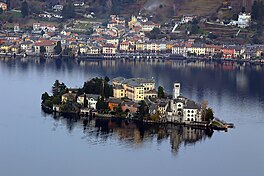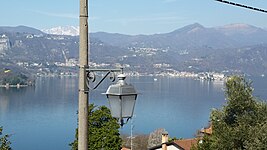| Lake Orta | |
|---|---|
| Cusio | |
| |
 Isola San Giulio Isola San Giulio | |
 | |
| Location | Piedmont |
| Coordinates | 45°49′02″N 8°24′24″E / 45.81722°N 8.40667°E / 45.81722; 8.40667 |
| Primary inflows | underground springs, Scarpia, Pellino, Plesna, Qualba, Fiumetta, Pescone |
| Primary outflows | Nigoglia |
| Catchment area | 116 km (45 sq mi) |
| Basin countries | Italy |
| Max. length | 13.4 km (8.3 mi) |
| Max. width | 2.5 km (1.6 mi) |
| Surface area | 18.2 km (7.0 sq mi) |
| Average depth | 71.6 m (235 ft) |
| Max. depth | 143 m (469 ft) |
| Water volume | 1.3 km (1,100,000 acre⋅ft) |
| Residence time | 8.9 years |
| Surface elevation | 290 m (950 ft) |
| Islands | Isola San Giulio |
| Settlements | Gozzano, Miasino, Nonio, Omegna, Orta San Giulio, Pella, Pettenasco, San Maurizio d'Opaglio |
Lake Orta (Italian: Lago d'Orta; Lombard and Piedmontese: Lagh d'Òrta) or Cusio (Lombard and Piedmontese: Cusi; Latin: Lacus Cusius) is a lake in northern Italy, west of Lake Maggiore.
It has been so named since the 16th century, but was previously called Lago di San Giulio, after Saint Julius (4th century), the patron saint of the region. Its southern end is about 35 kilometers (22 miles) by rail to the northwest of the city of Novara (located on the main Turin-Milan line), while its northern end is about 6 kilometers (4 miles) by rail south of the Gravellona-Toce railway station, itself located halfway between Ornavasso and Omegna.
Its scenery is characteristically Italian, while San Giulio island has some picturesque buildings, and takes its name from the local saint, who lived in the 4th century. The island was fortified between the 5th and 6th centuries.
Located around the lake are Orta San Giulio, built on a peninsula projecting from the east shore of the lake, Omegna at its northern extremity, Pettenasco to the east, and Pella to the west.
It is supposed that the lake is the remnant of a much larger sheet of water by which originally the waters of the Toce flowed south towards Novara. As the glaciers retreated the waters flowing from them diminished, and were gradually diverted into Lake Maggiore.
The inaugural European Rowing Championships were held on Lake Orta in 1893.
Frequent ferry service connects towns and villages around the lake.
Gallery
See also
References
- Romanoni, Fabio (2023). La guerra d'acqua dolce. Navi e conflitti medievali nell'Italia settentrionale. Bologna: Clueb. p. 23. ISBN 978-88-31365-53-6. Retrieved 28 April 2023.
- "Event Information". International Rowing Federation. Retrieved 15 August 2018.
- [REDACTED] This article incorporates text from a publication now in the public domain: Coolidge, William Augustus Brevoort (1911). "Orta, Lake of". Encyclopædia Britannica. Vol. 20 (11th ed.). p. 331.
- CNR - ISE: Laghi (in Italian)
- LIMNO Banca dati dei laghi italiani: Orta (in Italian)
External links
- Lake Orta at World Lake database
- [REDACTED] Media related to Lago d'Orta at Wikimedia Commons
- Orta.net (in Italian and English) Pictures, history and curiosities about lake of Orta
| Lake Orta (Lago d’Orta, Cusio) | ||
|---|---|---|
| Settlements | ||
| Islands | ||
| Rivers | ||
| Landmarks | ||
| People | ||


